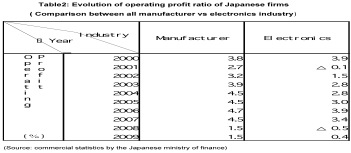|
The electronics industry is critical when considering Japan's competitiveness, because it has driven the Japanese economy, along with steel and automotive manufacturing, providing larger market opportunities and job creation. However, Japanese global players in the electronics industry have been facing serious unprofitability problems, although they have invested a high level of research & development, and introduced numerous world-leading new products, such as the DVD, flat screens, digital cameras, and mobile phones for a global market (see tables 1 & 2)


This serious unprofitability problem leads to loss of competitiveness, not only in the short term, but also in the long term because the Japanese electronics manufacturers are not able to continuously invest in developing strong products that meet consumer needs.
Why are Japanese manufacturers in the electronics industry not enjoying profitable business?
The author’s tentative answers to this question are as follows:
1. Firstly, there is an absence of a clear scenario which outlines a profitable value chain. It is necessary to build a better business model that identifies the source of profit, and that considers how the company strengths fit to that model.
It has been said in the ‘smile curve’ theory of profit in the value chain, that higher profitability can be found in both the downstream and upstream sections of the value chain, but not in between at the manufacturing site. However, lots of Japanese manufacturers still think that manufacturing and parts assembly is a source of competitiveness.
It is also necessary to reconsider the profit scope of the business in conjunction with its strengths as a manufacturer, such as manufacturing services (promoting consumables goods sales, maintenance and contents business), enhanced upstream business (entry into material business), and direct business incorporating the distribution function.
2. The second reason arises from an excessively strong organizational culture based on process innovations, such as “Kanban” and “Kaizen” that have prevented the reconstruction of the core business in order to match environmental changes, and thus create profit as an implementation of strategy.
Because of Japanese manufacturers’ rigid approach, the implementation of core business reconstruction is rarely implemented until it is too late and the business collapses. This strong process-oriented culture has forced employees to do everything they possibly can to increase sales and profits and to prevent the collapse of business, but this in return, has resulted in delayed or difficult implementation of reconstruction of the core business.
3. The third reason is the gap between recognition of technology value and market needs in the process of global business development. In order to collect returns from the high level of investment in technology innovation, businesses need to pursue economies of scale for production and sales through expanding into the global markets.
However, the high product quality of Japanese manufacturers, with associated high prices, does not fit customer needs in emerging markets, who instead prefer the low-end price products. This is not just a matter of pricing, but also a matter of scope for product development; how to meet customer needs, and capture the necessary technology developments.
As someone who has worked in the electronics industry over 30 years, I have identified the key factors within Japanese firms in the electronics industry which relate to globalization (Nagashima, 1999) and innovation through collaboration with retailers (Itoh and Nagashima, 2009).
Facing new challenges to secure profitability through continuous creation of technology innovation, it is essential for Japanese firms to promote growth strategies. Consequently, Japanese firms in the electronics industry cannot escape globalization that, in turn, could lead to business growth, by pursuing economies of scale for production and sales. Hence, from a globalization viewpoint, I would like to observe and make in-depth analysis of, how Japanese firms try to solve the above mentioned problems, using my empirical studies within the industry. I hope that these empirical studies, based on an insider’s knowledge of the business and its organizational relationships, can contribute to clarify a complex phenomenon in the real business world.
-------------------------------------------------------------------------------
Reference
Nagashima, “Innovation Management for Globalization -The Case of Japanese Enterprise”, working paper of Kobe University, 1999 Oct. (In Japanese)
Itoh and Nagashima, “Global Supply Chain Management”, Journal of Marketing & Distribution, 2009 June.Vol.12, No.1. pp. 33-48. (In Japanese)
|
|











